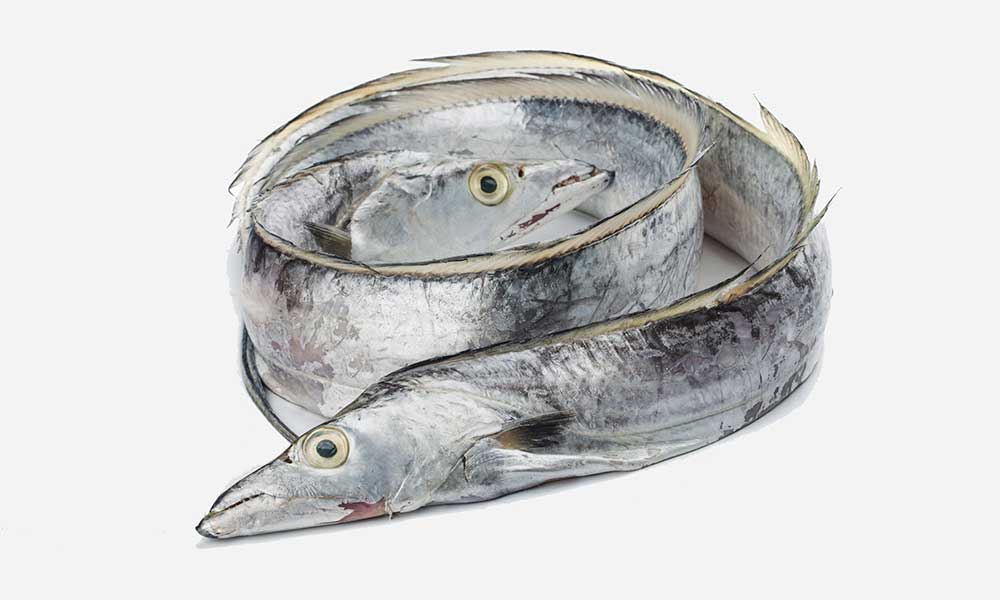
Fat (Per 100 gr)
3 g
Calories (Per 100 gr)
350 Kcal
Carbs (Per 100 gr)
1 g
Protein (Per 100 gr)
18 g
What is Ribbon Fish?
Any lampriform fish in the Trachipteridae family is known as a ribbonfish. The slender, ribbon-like appearance of these pelagic fish has earned them the moniker. They reside in deep waters and are not bottom feeders, thus they are rarely seen alive. The red bandfish (Cepola microphthalmia), a perciform fish, is commonly referred to as a ribbonfish, but it is unrelated to any ribbonfish in the Trachipteridae family.
Their anatomy is easily identifiable: a long, compressed, tape-like body, a short head, a narrow mouth, and feeble teeth. A long, high dorsal fin runs the length of the back; an anal fin is lacking, and the caudal fin, if present, is made up of two fascicles of rays, the upper of which is extended and oriented upwards. The pectoral fins are tiny, while the pelvic fins are made up of many rays or a single long ray.
They have numerous bumps on their skin and hefty spines along their lateral lines. Ribbonfish have all of the features of fish that live at extreme depths. Their fins, in particular, as well as the membrane that connects them, have a delicate and brittle structure. Some of the fin-rays of young ribbonfish are abnormally lengthy and sometimes have appendages attached to them. Specimens were collected in the Atlantic, Mediterranean, Bay of Bengal, Mauritius, and Pacific oceans. The Atlantic species has been found primarily along the northern coasts of Iceland, Scandinavia, Orkney, and Scotland. The North Atlantic species is known as deal fish in English, vogmaer in Icelandic, and vogmär in Swedish. Its average length is 5 to 8 feet (1.5–3.5 meters), although it can grow to be over 20 feet long.
Specimens appear to be driven to the shore by winter gales and occasionally left by the tide. However, in Scandinavia, S. Nilsson observed a living specimen moving like a flatfish with one side turned obliquely upwards in two or three fathoms (4–5 m) of water. In November 2007, a Trachipterus ishikawae specimen was discovered alive but with a 10-cm cut wound on its side on a beach in Kenting, Taiwan, and was returned to deeper water.
In Taiwan, the species Trachipterus ishikawae is known as "earthquake fish" because the fish are thought to arrive after significant earthquakes due to their claimed sensitivity to disturbances in the ocean floor. Following a 100-year earthquake in Hengchun in late 2006 and in Taitung in 2007, as well as other recent sightings around the Japanese coast in March 2010, records of such appearances were made, however other recorded sightings do not match with seismic disturbances.
Ribbonfish is one of the best fish on the market, in addition to its unique appearance and taste, is very famous in the treatment of sexual problems. This fish lives in temperate and relatively cold waters and feeds on shrimp and despite other animals, the baby's eggs are raised in the male body.
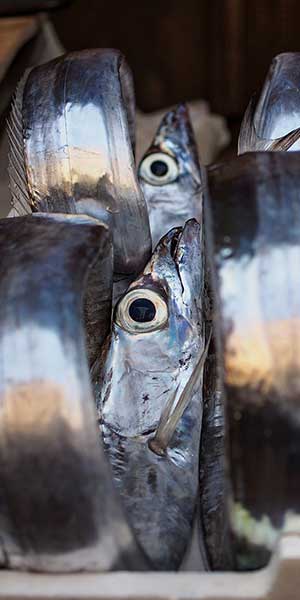
Persian Gulf Ribbonfish
This kind of fish can be found in the Persian Gulf. Ribbon fishes are black when they are unmatured. But their color starts to change to silver as they get older. Black ones live in the depth of the sea but sometimes they get caught east of the Persian Gulf or we can see a mixture of black and silver skin on harvested Fishes.
The farmed Ribbon fish west of the Persian Gulf have a better quality because they have more time to weigh and grow. They're sliver and bigger. For example, Bandar Jask harvests mixed color Ribbon fish but Bushehr harvests great Ribbon fishes with shiny silver color.
IRAN Ribbon Fish Export
There are more than 50 companies that process, pack and export this fish in 4 southern provinces:
Due to Water entry from the Indian Ocean and density differences, the water flows in the Persian Gulf are counter-clockwise, which means the water enters from the east side and moves toward the west side of the Gulf.
Subsequently, this flow causes the movement of aquatic creatures with the same path. Ribbon fishes are black in terms of color and mostly live in the depth of the ocean, as their age increases, they need to adapt their body to water pressure so that they gradually approach the water surface and the color of their body changes into silver and their skin becomes more transparent.
The color of the ribbonfish on the east side (Bandar Jask) of the gulf may have dark veins, but on the west side (Boushehr) of the gulf, their skin is completely silver and transparent so it’s more expensive.
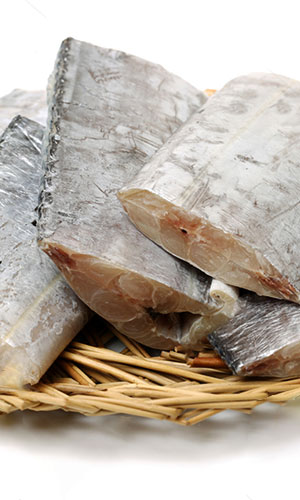
Ribbon Fish Health Benefits
Ribbonfish is a calorie-dense form of fish, with a 100-gram portion containing roughly 350 calories. In 100 grams of this fish, there are only 3 grams of fat. which is very useful for those who are looking to lose weight.
Eating ribbonfish has a lot of health benefits, including the following:
Good for the heart
Ribbon fishes have a high level of unsaturated and omega-3 fats. The combination of these two can protect the heart from various ailments like lowering the blood’s cholesterol level and lowering the risk of clotting blood inside vessels.
Protects the eyes
The omega-3 is beneficial for keeping your vision to its maximum capacity. it is a fatty acid that can prevent the eyes from macular degeneration. Macular degeneration is an age-related condition that makes your vision blurry.
Soothes the pain of Arthritis
Ribbonfish has some anti-inflammatory elements which will reduce pain.
Boosts cognitive performance
omega-3is beneficial in improving the cognitive performance of a child. It increases concentration, improves behavior, and reading skills, and cures ADHD or attention deficit hyperactivity disorder of a child.
Good for overall skin health
There is no need to buy lots of these wealth-draining products though because Ribbon Fish can provide more than these products can promise.
Precautions
Due to the high load of Sodium, we recommend watching your Ribbon fish intake.
Spawning & Fishing
This species of fish spawns all the year, but its spawning season is in spring and autumn. the fishing season starts in May and continues to September.
-
1
Spawning
Spring, Fall
-
2
Fishing
May - September
Ribbon Fish Processing
Fishing
There are two types of fishing which are by hook or by a net. Fishes that are harvested by hook have better quality and their skins are Intact but at the same time fishing by net can injure their skins and even their flesh and organs.
Ribbon fishes are categorized into 3 types of AA, A, and B based on fishing.
- AA: Fished by hook and the body is intact and without scratches. eyes are white and completely glossy.
- A: Fished by hook or creel but the body has scratches. and some of them have yellowish eyes.
- B: Fished by creel, the body has scratches and also raptures. and some of them have yellowish eyes.
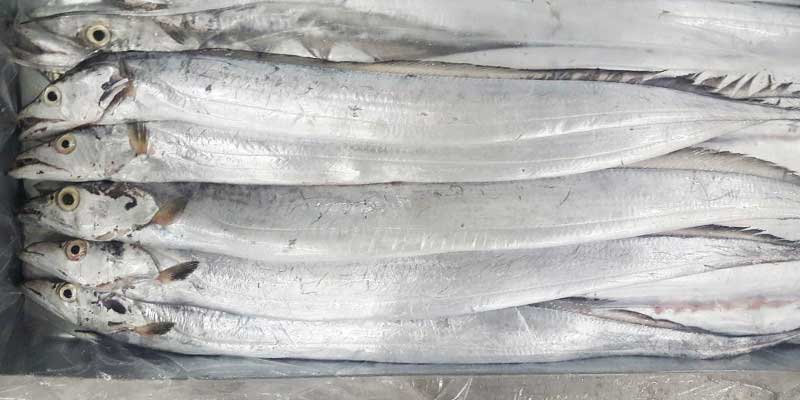
Ribbon Fish | Quality A
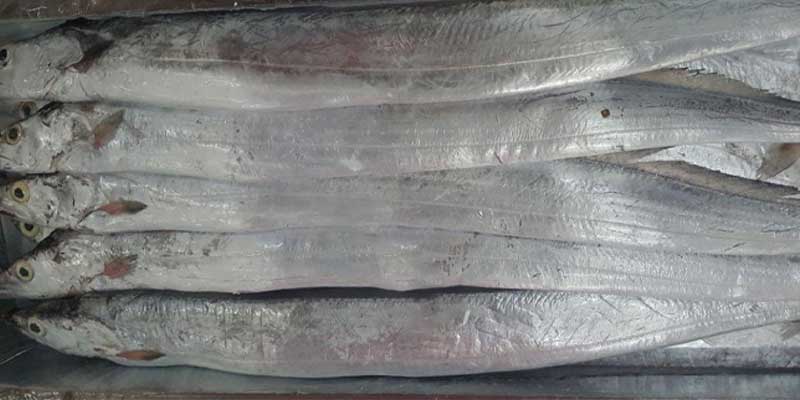
Ribbon Fish | Quality B
Sorting
After fishing, the Ribbon fishes will get transferred to the factory immediately. At this time workers start to sort. The laborers sort the fishes base on their Quality (AA, A, B) and Size. this chart shows the sizing range based on the weight (grams).
| 1 | 100-200 | 58-62 |
| 2 | 200-300 | 38-42 |
| 3 | 300-500 | 23-27 |
| 4 | 500-700 | 15-18 |
| 5 | 700-1000 | 11-14 |
| 6 | 1000-UP | 7-10 |
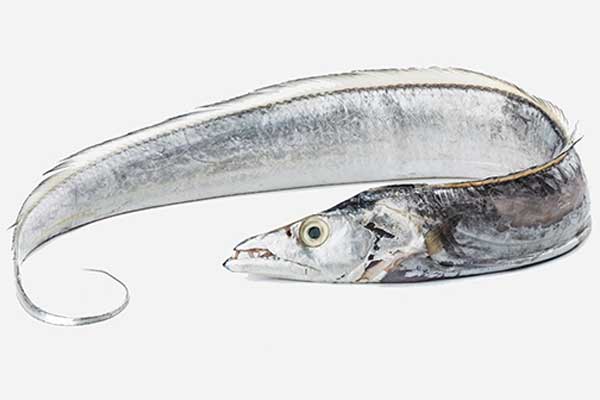
1000/UP
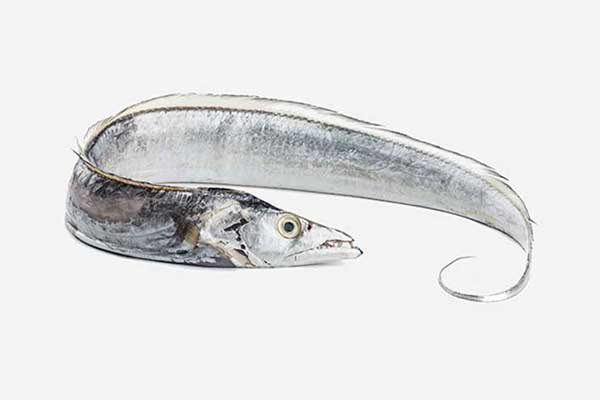
300/500
Packing
After sorting, the workers start to pack the fish based on their quality. There are two types of packaging that are IWP and Block.
- IWP: every fish is packed in nylon and all nylons will pack in a carton.
- Block: Other fishes with lower quality will pack in blocks. All fishes in a block have the same sizes and quality.
Freezing (-18° C _ -23° C)
After packing the factory starts the freezing process and after freezing, they will transfer to the buyer. It's worth mentioning that a vet is checking fish all the time and you can be sure about the hygiene of fish.
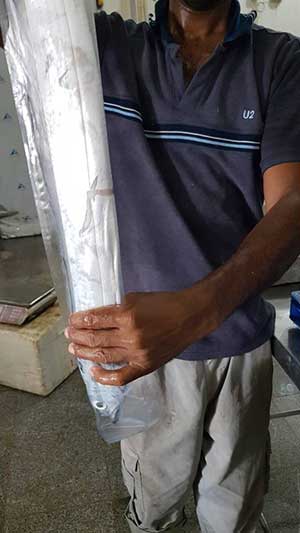
Ribbon Fish | IWP Packing

Ribbon Fish Price
HS-CODE: 030389
You can buy a kg of Ribbonfish for around 3-4$. There is a fee for packaging and shipping that should be added to the price of fresh fish. Based on every country's costume law and taxes the customers' price (local customers in destination countries) varies.
- Based on this article which is been written in May. 2022, the price of ribbonfish is between 2.6$ (16¥) and 4.2$ (28¥) per kilogram depending on the quality.
- 1 one 40 ft. container actually contains up to 27MT of this fish.
- Chinese buyers must be careful to buy from registered companies, the companies which are authorized by China Customs.
- The processing stages must be performed in the best way so you can make sure about the health and hygiene of the product.
How to Identify a fresh Ribbon fish?
It's about your senses, touch, smell, and sight. Trust your feelings you won't regret.
A fresh fish has a clear shiny eye
Examine the eyes of the fish before handling it. They should not be sunken or foggy, but rather clear, plump, and glossy. You can be fairly certain that the fish is fresh and healthy if the eyes appear to be in good condition. Even when they are fresh, some fish eyes (including Barramundi, Kingfish, and Mackerel) might have a somewhat foggy appearance due to them being swiftly cooled in ice after harvest, so look for plump, wet, and shining when inspecting their eyes!
A fresh fish doesn't smell like a swamp
A fresh fish should smell like mineral water or cucumbers, not like swamp water or have strong earthy, ammonia, or 'fishy' odors. Cooking won't get rid of them; in fact, it's more likely to make them stronger.
Check the flesh of fish
Give the fish a quick poke if the fishmonger allows it... The flesh should be resilient to the touch when touched, springing back as if you were pressing on your own body. The outside of the fish should be completely covered in a clear, translucent slime that has a pristine sheen to it. Scales should completely cover the skin; if they are loose or missing, this indicates age or exposure to extreme temperature.
Check the gills
The gills of a fish are a good sign of its quality. The gills are brilliant red when first captured, but they gradually darken over time, therefore the brighter the color, the fresher the fish. The gills, like the meat of the fish, should be clean and cool, not slimy.
It is preferred to buy a whole fish over fillets because you may use the strategies described above to ensure that the fish you're buying is of the highest quality. If you prefer a fillet, have your fishmonger 'Dry Fillet' the fish, which means filleting it without using or submerging it in freshwater. This may necessitate wiping the flesh carefully with a damp cloth (preferably bathed in saltwater) before using it, but it will ensure maximum flavor!
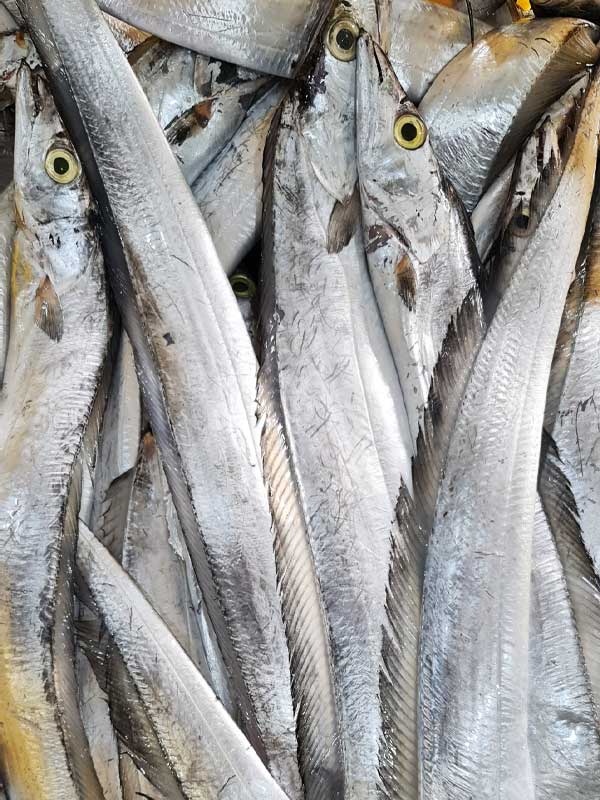
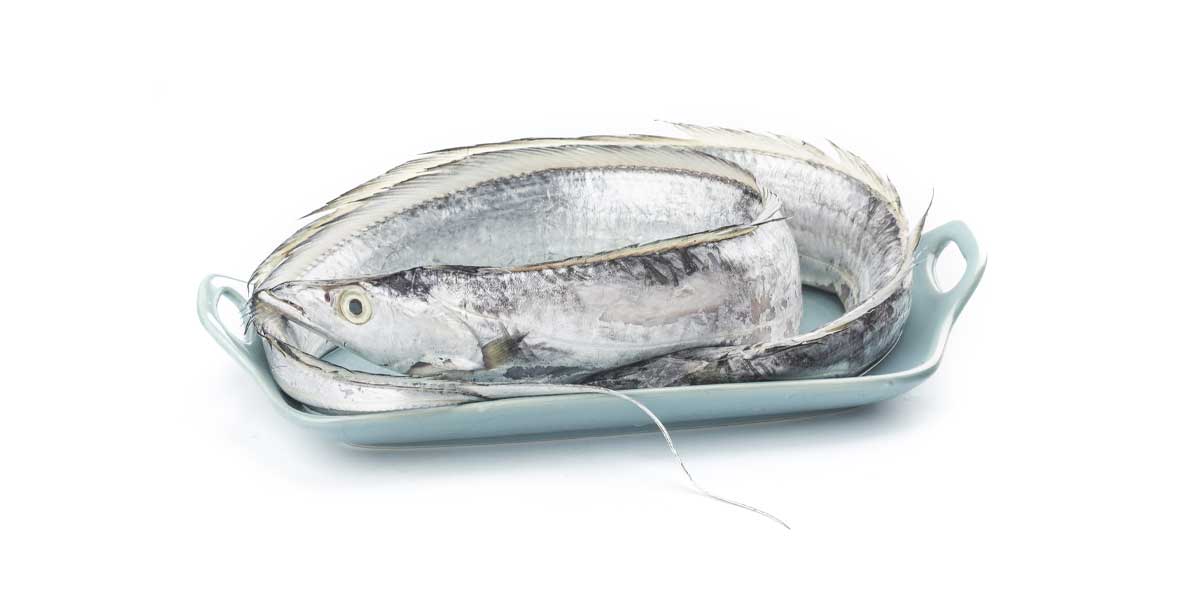
A delicious meal that can be cooked with Ribbonfish
Simple pan-fried Ribbonfish
Because of its basic tastes, crispiness, and buttery texture, this Simple Pan-Fried Belt Fish has been passed down from generation to generation.
Belt fish, also known as cutlassfish or ribbon fish, resembles a narrow belt with a sharply pointed head. Another aspect that stands out is its gleaming silvery skin (hence the name cutlass). They can be found whole on ice in Asian markets or sliced into sections in the freezer section.
Belt fish is steamed, red-braised, or pan-fried in China (particularly in and around Zhejiang province), though it is rarely seen on restaurant menus. It's eaten as sashimi in Japanese cuisine, while it's found pan-fried and in spicy stews in Korean cuisine. For this recipe try to find a fresh ribbon fish, but let me warn you that it isn’t a simple task.
Meats should be gently salted to preserve their natural flavor. You'll find a suggested salt range in this recipe, but I'll leave it up to you to decide.
This fish can be served hot, cold, or at room temperature. It may sound strange, but as long as you have a bowl of steaming steamed rice or porridge, they're all fine!
It's recommended not to reheat fish as a general rule because it tends to taste extra fishy afterward. If you don't want to eat cold fish straight from the fridge, set it out for 30 minutes to bring it up to room temperature before eating.
Instructions
- Clean fish
Scrape the beautiful silvery outer layer off the entire fish with a dull knife or the side of a scissor blade. The silvery part of the fish skin can taste fishy, so this step is optional.
Trim the fish's gills, guts, and black membrane, as well as any traces of blood, off the large center bone that spans the length of the fish.
- Marinate the fish
Place the fish in a serving bowl. Season the fish with salt and pepper, then add the Shaoxing wine and julienned ginger.
- Cook the fish
Remove all chunks of ginger from the fish. You now have two choices. You can cook the fish plain or cover it with flour to give it a crunchy coating and keep it from sticking to the pan or coming apart—this is a smart precaution for anyone new to pan-frying fish.
